Uniforms Strut Their Stuff at FIT
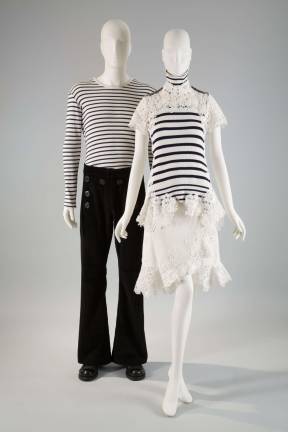
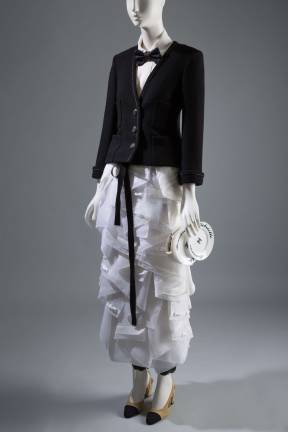
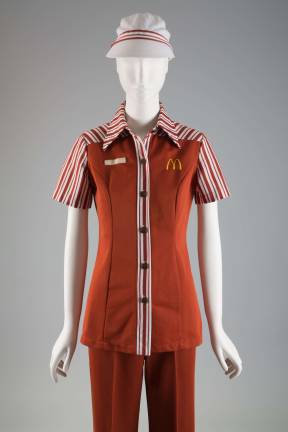
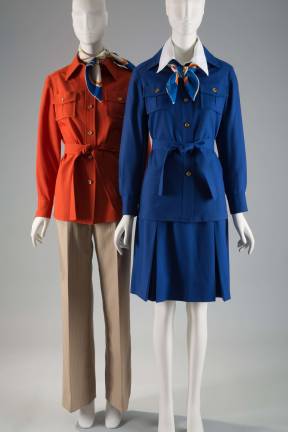
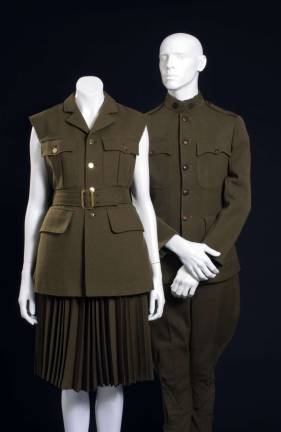
They are ubiquitous and almost everyone has worn one. Uniforms are identity markers, signaling membership in a group: school group, work group, military group or sports group. Members of the group stand out — think of the Olympians at Rio — and get lost in the crowd. The outfits are prized for their efficiency and scorned for their sameness, sameness being at odds with fashion, which puts a premium on creativity and individuality.
But as The Museum at FIT argues in a well-curated show, “Uniformity,” the fashion industry has been cherry-picking from uniforms for some 150 years. Military uniforms, especially, have provided designers with inspiration for high-concept garments. Gold buttons, ornamental braids, stripes and sailor suits have been embraced and subverted by the likes of Ralph Lauren, Yves Saint Laurent and Coco Chanel. Masculine attire informs feminine attire in a neat twist, and stuffiness gives way to style and elegance.
The exhibit of some 70 items from the museum’s permanent collection is a history show and a fashion show, with historical pieces paired with the pieces they influenced. The curator, Emma McClendon, moves us thematically from military uniforms to uniforms for work, school and sports. An introductory video features Stan Herman, an authority on the subject and pioneering fashion designer for corporate giants like Avis, FedEx, TWA and McDonald’s. His retro red-and-yellow McDonald’s uniform from 1976 is on display, with a small golden arch in the shirt-pocket area heralding the brand. The curator juxtaposes this standard-issue work dress with a 2014 couture riff from Moschino’s Jeremy Scott, who takes the logo (“M”), enlarges it and emblazons it across the front of a red and yellow wool top — and then adds “Moschino” underneath. It’s another brand advertisement, only bigger, bolder and way more chic.
Herman’s uniforms for TWA flight crews broke the mold and introduced bright colors and safari jackets to telegraph the good life. “Color is the most important thing in uniforms,” he says about his use of red, orange, yellow and cobalt blue for the airline’s clothing. “It represents who these monster corporations are.” Two of his eye-popping ensembles are on exhibit and bring us back to the Seventies. Picture relaxed passengers en route to luxurious destinations being handed a martini from one of these suited-up attendants.
Martial history fans can revel in the rich displays of U.S. and British military uniforms. The show opens with two formal British “mess dress” jackets (ca. 1900), adjacent to a form-fitting imitation of the King’s Royal Rifle Corps jacket by Ralph Lauren for his fall 2013 women’s collection.
What follows is a parade of iconic outfits — a Royal Highlanders (Black Watch) uniform (ca. 1905), a U.S. Army Colonel “Dress Blue” uniform (ca. 1950), World War II WAVES (Women Accepted for Volunteer Emergency Service) and WACS (Women’s Army Corps) uniforms, plus U.S. Navy sailor suits, an “Ike” jacket, a “Jeep Coat” and, in a nod to the French Navy, a striped Breton-style shirt, courtesy Jean Paul Gaultier in the early ‘90s.
Fun fact: the blue-and-white stripes of the Breton shirt, which officially became part of the French Navy’s uniform in 1858, functioned to help spot shipmen who fell overboard. Also known as the marinière, the top inspired a striped ensemble by designer Chitose Abe for Sacai in spring 2015. A lacy confection with a turtleneck, it’s a yin-yang blend of feminine and masculine elements.
Couture and frivolity mix easily here with no-nonsense, utilitarian garments. An olive drab man’s U.S. Army uniform from World War I is flanked by a mud-colored, sleeveless Comme des Garçons (Rei Kawakubo) ensemble from 1998, frayed at the armholes for decorative purposes. On the same platform, Marc Jacobs delights in contradiction with a creation from spring 2010 that couples a copy of a boxy Army field jacket with a long, breezy skirt.
Some of the most dazzling fashion statements draw inspiration from camouflage, widely used during World War I. A U.S. Marine poncho and helmet cover share the stage with an off-the-shoulder camouflage gown by John Galliano for Dior (spring 2001). Featuring a long sexy slit up the front and a train, the latter “has a deconstructed quality, as if it were thrown together from an army tent or poncho,” the exhibit label states. The print that was meant to conceal now boldly reveals.
Karl Lagerfeld’s take on a Parisian waiter’s uniform for Chanel in 2015 is possibly the show’s most inventive costume. With bow tie, short black jacket and white ruffled skirt mimicking an apron, this haute version of a brasserie uniform boasts a jokey clutch purse made of plates bearing the Chanel logo and the words “Brasserie Gabrielle” (Gabrielle Chanel, better known as Coco, was the founder of the House of Chanel).
We all have our personal style, personal uniforms. The curator connects the dots in the show’s brochure: “Although we may not each wear an official uniform in our everyday lives, the influence of uniforms can always be felt, even in the basic activity of getting dressed each morning.”
“Uniformity” at The Museum at FIT; Seventh Avenue at 27th Street. Through November 19. www.fitnyc.edu/museum